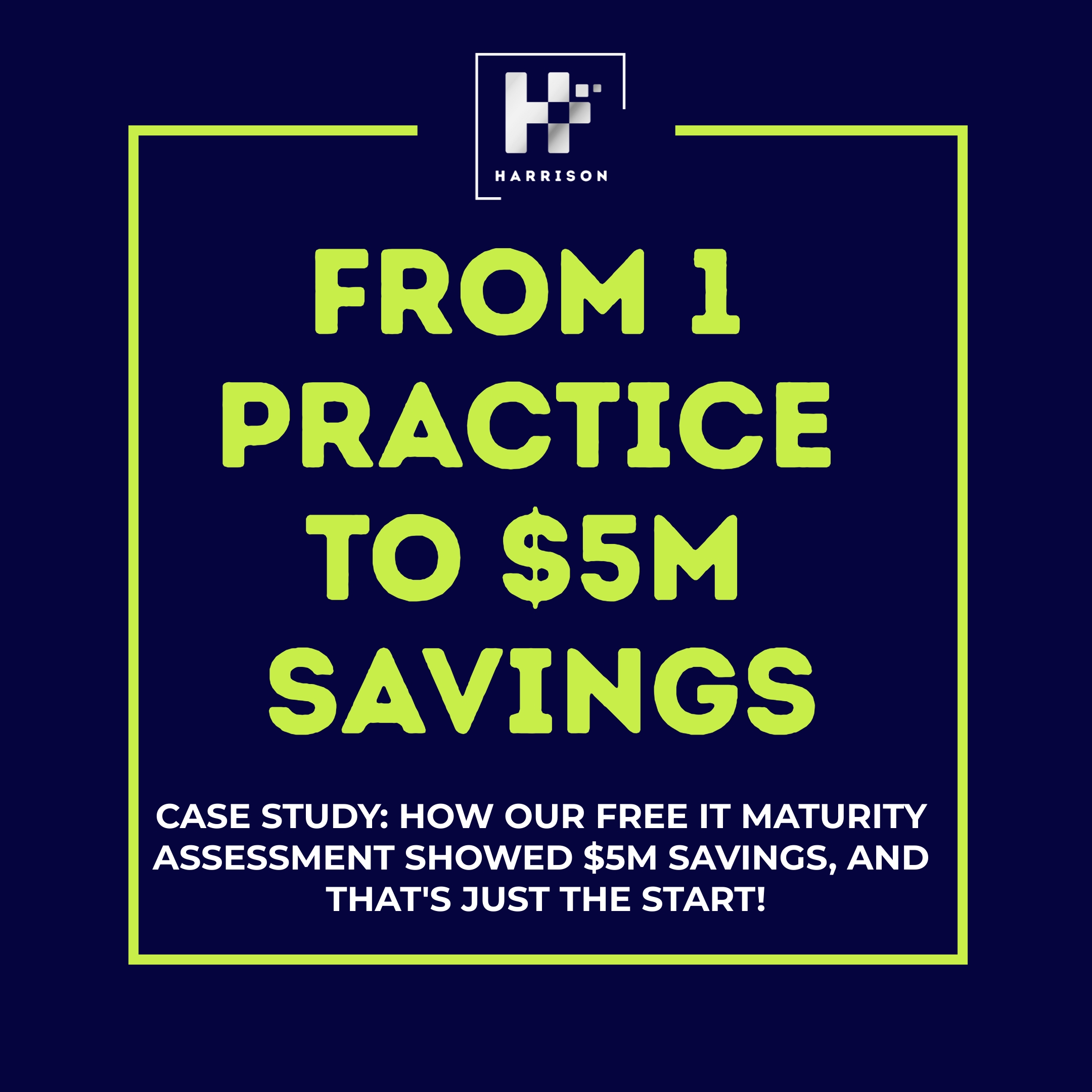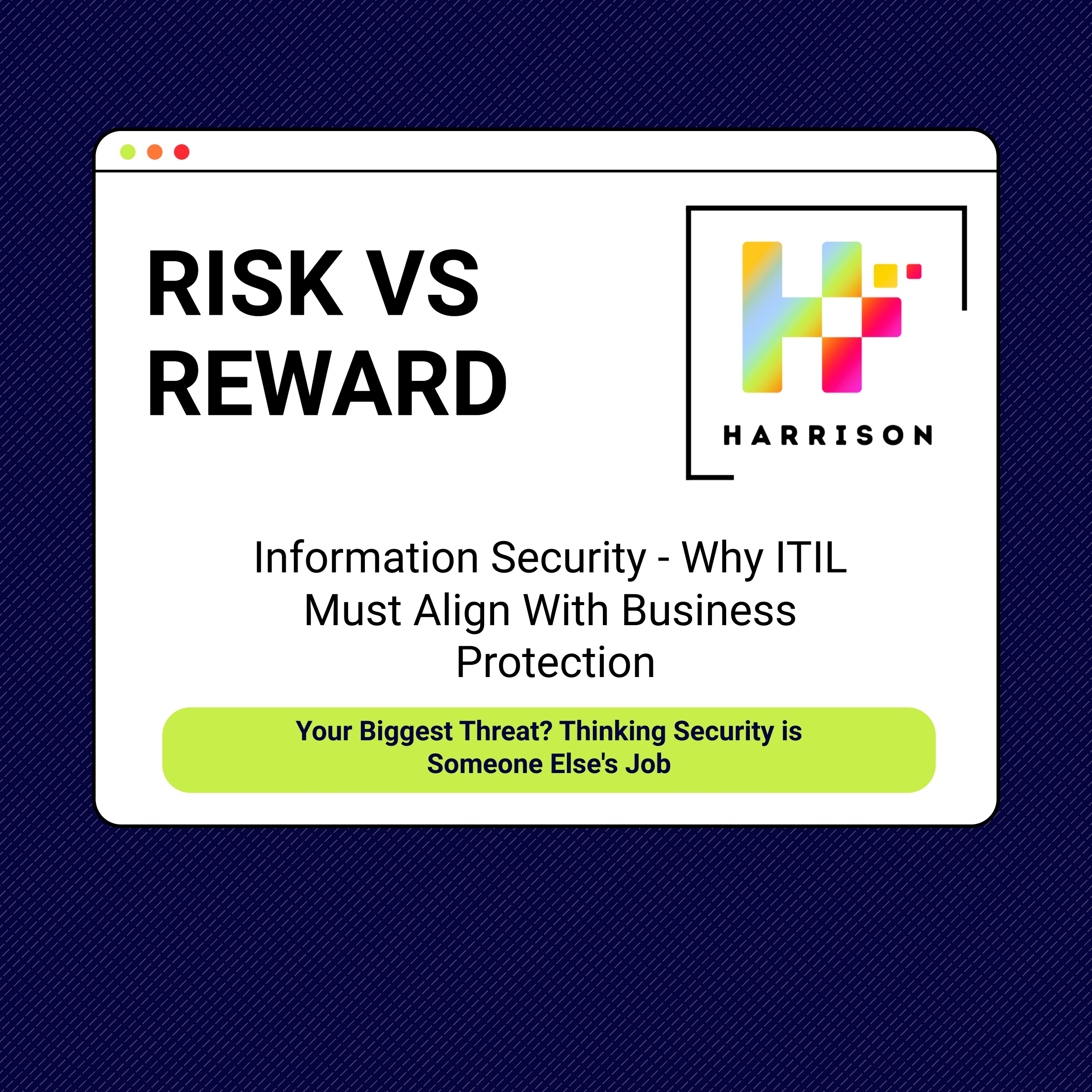The Case For IT Service Management
IT Service Management is still the heartbeat of IT services, making sure that the IT services we provide to our customers are available, stable, reliable, scalable and every other “able” you can think of! If you want to know why and the things you can do to ensure it is effective, you’ll love this blog.
Lets dive right in…
-
Introduction
-
Topics & Scope
-
Cost Vs Value
-
What is an IT Service?
-
IT Service Management
-
Common Problems
-
How do we Address it?
-
The Case For IT Service Management
Introduction – Why is IT Important?
-
In the UK approx. 1 in 20 people work in IT & telecoms
-
Over 30 million people use IT in their daily jobs
-
Less than 1% companies worldwide could cope without the Internet
-
IT represents a large % of total business expenditure
-
Many business functions totally rely on IT
-
IT doesn’t just support business, IT powers business
-
IT is at the heart of industry and fundamental to our lives
-
Most organisations depend on IT to help them achieve their vision, strategy and objectives
-
Organisations use IT to:
1) Transform the way they operate, communicate, and do business
2) Innovate, gain market advantage, and differentiate themselves
3) Improve productivity and increase sales and growth
4) Improve business processes and efficiency and make cost savings
5) Communicate with a global marketplace

Topics & Scope

Cost Vs Value
-
The cost of IT is never insignificant
-
It is important to get good value from IT investments
-
However, the potential business value is not always realised
Where does the business get value and benefit from?
-
From IT applications / services in live operation
-
Not from projects in development
What Is an IT Service?

IT Service Management
For an IT investment to deliver its potential value, the resulting IT service needs to be:
-
Well planned,
-
Well designed,
-
Well implemented,
-
Well delivered, and
-
Well received
This is what the practice of IT Service Management is about
-
The professional practice of planning, designing, developing, delivering and optimising IT services that are both fit for purpose and fit for use – thus ensuring value and return on investment can be maximised
-
A specialised discipline that includes the methods, processes, activities, functions and roles needed by a service provider to deliver IT services that provide business value for its customers
-
A growing profession of people, skilled and committed to delivering high-quality IT services that provide measurable value for the businesses that use them
Benefits of Good IT Service Management
-
IT services that align with business priorities and objectives – helping the business achieve their strategic objectives
-
Known, manageable IT costs – helping the business manage its Finances
-
Reliable services that work when the customers need them – leading to better business efficiency, effectiveness, and productivity
-
Improved resource management and reduced rework within IT saving the company money
-
More effective management of change – enabling the business to keep pace with change and drive change to its advantage
-
Better customer satisfaction with IT – and better end-customer perception and brand image
Common Problems
These are the common problems we find we come across with our clients when they engage us. do you recognise any of these symptoms?


-
IT must be of value to the business
-
IT must be possible to see a direct or indirect link between the IT and the business processes / priorities / objectives
-
If any IT component doesn’t have a purpose relevant to the business, then its existence should be questioned
Recognising Good & Bad Practice
|
Misalignment between IT and the business: |
Alignment between IT and the business: |
|
|
What Should We Consider?
-
Business relationship management – high level, strategic relationship between IT and the business / customers
-
Good understanding of the business, business priorities and objectives
-
Service portfolio management – understanding the Service Catalogue (services in operation) and the Service Pipeline (services in concept or development) and making sure they all have a clear business purpose
-
Clear (direct or indirect) value chain between all aspects of IT services and the business activities and objectives
Lack of customer Focus
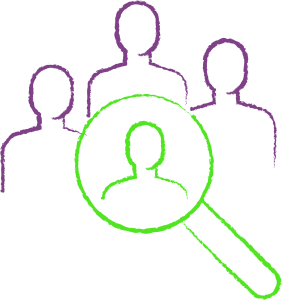
-
The customer must be at the forefront of our mind
-
Just because we think we are doing a good job, the customers do not always feel the same way
-
We need to be aligned on what success looks like and how we measure it
Recognising Good & Bad Practice
|
Poor customer focus: |
Good customer focus: |
|
|
What Should We Consider?
-
When designing the service and SLAs, focus on what is important to the customer and test the customer’s understanding of the service levels
-
Make sure service levels are written from a customer perspective
-
Maintain an ongoing dialogue with the customer – check their expectations and perceptions regularly
-
Important to have staff with good ‘soft skills’ involved
-
Don’t rely solely on agreed service levels because requirements change over time – regularly check whether the customer is happy with the service and what is important to the customer
Poor Linkage Between Projects & Operations
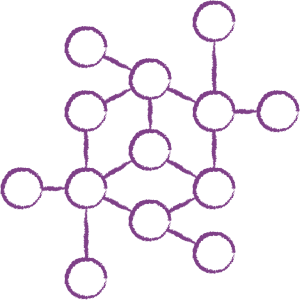
-
Projects and operations must start together and work together.
-
A key measure for success of any project must be that it is delivered with no disruption to the customer and meets the business case that was approved by the customer
-
Transition needs to act as the gatekeeper to Live Operations but is constrained by the strength and maturity of the other Service Management capabilities
Project / Development Process
When delivering a project the standard framework or methodology is below. The lens that you look through when delivering is always through the lens of the project team and the product that is being built.

Handover to Operations
The handover to operations feels like this for many of our clients. We have all experienced the hit-and-run approach of projects and that they get thrown over the fence to IT operations to then run. This is a common practice!
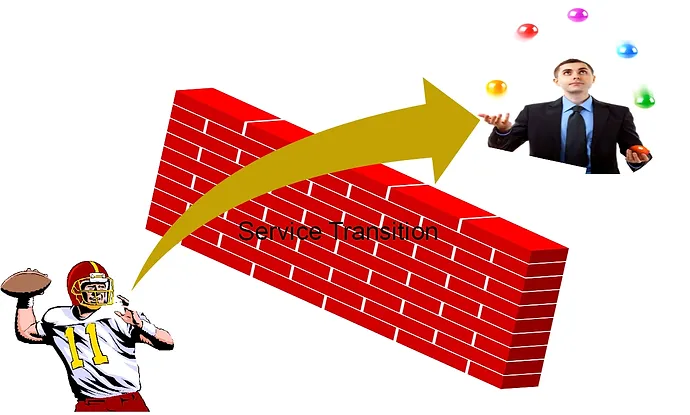
Recognising Good & Bad Practice
|
Poor linkage between projects & operations |
Good linkage between projects & operations |
|
|
What Should We Consider?
Aspects of IT service, which need to be planned, designed, developed, tested, implemented include:
-
Service solution
-
Architectures
-
Infrastructure components
-
Measures and metrics
-
Management information system, tools and techniques
-
etc……Think of the Iceberg
Can We Do It Differently?
Of course we can!!! Imagine how the project lifecycle / framework would look if the operations team were involved from the very beginning…..
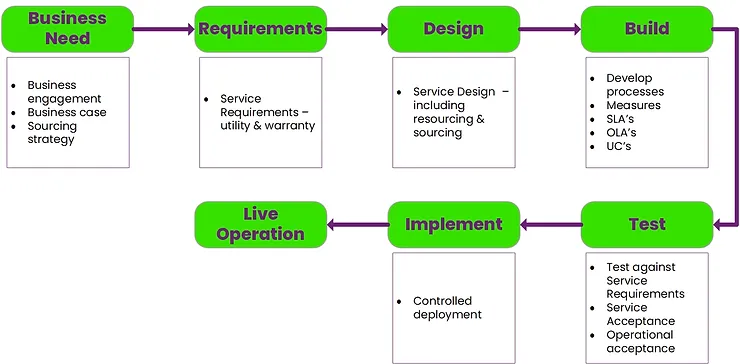
Focus on Service Utility & Not Service Warranty

-
Common oversight from IT organisations and even knowingly neglected.
-
Fit for purpose, but not fit for use.
-
True value of a service is created if it is fit both for purpose as well for use. It must meet the conditions for both the utility and warranty. And only then, a service is valuable.
Likely to result in:
-
Service levels below expectations
-
Operational costs above expectations or not clear
-
Problems with operational service
-
Project Team disappeared
-
Operations ‘Responsible’ to sort out the ‘problem’
-
Lack of or no data on the performance of the service
Recognising Good & Bad Practice
|
Focus on utility but not warranty: |
Focus on both utility & warranty |
|
|
What Should We Consider?
It is a common mistake to design IT services that are fit for purpose but not fit for use.
-
This will delay (or even prevent) the delivery of business benefits
-
Retro-fitting IT service design later is a high-risk strategy, which will be more costly and may even prove impossible
-
Once in operation, it may well be too late to make significant impact on the cost of ownership of an IT system
-
Once developed, it may be too late to get the service levels expected at a reasonable cost – and sometimes the required service levels cannot be met at all – meaning business benefits won’t be achieved
-
Service improvement can only do so much, it cannot re-engineer the operational design of a system or service
Focus on Utility & Warranty
-
Meaningful debate on service level options and costs BEFORE constrained by application design
-
Define the service in terms of all its service requirements – warranty requirements as well as utility requirements
-
For significant changes / projects / new services, create a service design package (SDP) and service acceptance criteria
-
Warranty requirements include – Capacity, Security, Availability, Reliability & Continuity
|
Hours of Service Availability Backup & Recoverability Service Continuity Security Privacy |
Response Times & Throughput Capacity & Growth Resilience to Incident Robustness to Business Change Need for Flexibility Level of Data Integrity |
Poor Cost Management

-
Everything we do must make financial sense
-
The business need to consider IT as good value for money
-
Cost and value are 2 very different things
|
Poor cost management: |
Good cost management |
|
|
What Should We Consider?
It is a common mistake to focus on one off project costs but not the ongoing operational costs. Or, to focus on the costs associated with utility but not warranty
-
Consider all costs, including development of the service and all ongoing operational costs
-
Discuss costs with the customer at an early stage during service design
-
Costs should be considered alongside functionality and performance (as well as delivery schedule) – plan to achieve a balance that is acceptable to the customer
Understanding Costs & Cost of Ownership

Poor Service Transition

-
This is the gatekeeper to live operations – so use it like it!
-
It is only as good as the capabilities that sit behind it
-
Don’t just use transition for new services, use them for big changes too
Recognising Good & Bad Practice
|
Poor transition management: |
Good transition management: |
|
|
What Should We Consider?
A common mistake is to rush through the transition of the service from the project team into live services
-
You get out what you put in with service transition and it is only as strong as the capabilities it is representing. Ensure that when building out your Transition policies, methods and plans that you engage each capability owner and ensure their requirements (SAC) form part of the Service Design Package.
-
Don’t Transition as a silo activity. For each transition build a working quorum – Transition Analyst, Service Owner & Live Service Operations representative at minimum.
-
Ensure you have clear go/no go gates and all parties agree to the terms of reference of them.
-
Transition needs to be funded by the production/service operations teams not the project! They are there to protect live service and if funded by the project they will be influenced by the project.
Continual Firefighting

-
A brilliant barometer to gauge how well new services land into Live Service Operations.
-
The Live Service Operations team will feel like the are playing an adults version of wack-a-mole!
-
If there is constant firefighting it is vital to recognise something is not right.
Recognising Good & Bad Practice
|
Poor operational management |
Good operational management |
|
|
What Should We Consider?
A common mistake is to rush through the transition of the service from the project team into live services
-
Get CSI up and running in full and make iterative improvements to not just the Business/Application Services, but the capabilities too.
-
Ensure how we manage Incidents and large outages demonstrates learning to both the wider IT organisation and the business
-
You feel the benefit of ITIL in the Services operations space; but to get there, you must do everything to the left of it.
How do we Address it?
The Service Lifecycle
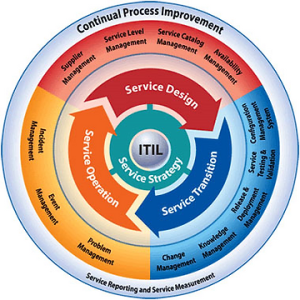
Service Strategy – Benefits & Features
-
Focus on the value of IT services from the perspective of the business
-
A portfolio of IT services that support business strategy and align with business objectives
-
IT investment decisions result in tangible and quantifiable business value
-
IT costs are planned, understood, agreed with the business and managed
-
A strategic approach to service development, so that IT services benefit from industry knowledge and corporate learning
Service Design – Benefits & Features
-
IT services are designed to meet business objectives
-
IT services are designed to be both fit for purpose and fit for use
-
The Cost of ownership of each service is planned to achieve a return on investment
-
Functionality, cost and performance are balanced – services are designed so that functionality, cost and performance are acceptable to the customer
-
Potential risks are considered during service design and mitigated, so the resulting IT service has designed protection from threats
-
The resulting IT services are more stable and predictable once in operation
Service Transition – Benefits & Features
-
IT changes are managed and controlled
-
Failures and service disruptions resulting from change are reduced
-
Unexpected impacts to day-to-day operation as a result of change are avoided
-
Change cycle time is reduced significantly
-
More change can be achieved, faster, cheaper and with less risk, which potentially drives additional value for the business
-
The pace of change creates organisational agility
Service Operation – Benefits & Features
-
Business customers are able to achieve the expected benefits and get value from their operational IT
-
IT services operate reliably and securely, avoiding failures and unexpected disruptions
-
Incidents and problems are dealt with professionally and responsively, addressing root cause as well as symptoms
-
Customers are kept well informed and users have confidence in the operational IT services they use
-
Costs are kept under control
Service Improvement – Benefits & Features
-
Learning from experience and making improvements
-
Reviewing IT services regularly to ensure they are still aligned with changing business requirements and priorities
-
Looking for ways to improve quality, reduce costs, improve effectiveness and efficiency
-
Taking advantage of technology improvements where appropriate
-
Creating organisational agility through continual improvement of quality and reliability of critical IT
A Case For IT Service Management

|
Benefits of good IT Service Management |
Risks & issues of poor IT Service Management |
|
|
If you would like to know more about the benefits of IT Service Management or want to talk about the options of how to implement a right-sized Service Management operating model in your organisation, get in touch with us today!
020 3667 3666
Follow us
Latest articles
December 13, 2025
December 13, 2025
December 13, 2025
December 13, 2025
December 13, 2025
December 13, 2025

